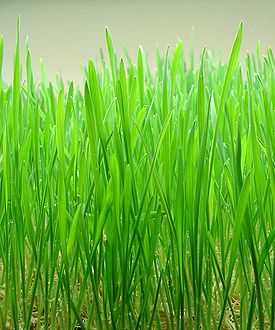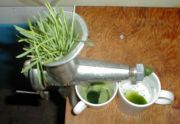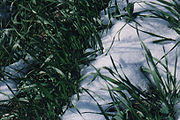
Wheatgrass
Encyclopedia

Cotyledon
A cotyledon , is a significant part of the embryo within the seed of a plant. Upon germination, the cotyledon may become the embryonic first leaves of a seedling. The number of cotyledons present is one characteristic used by botanists to classify the flowering plants...
s of the common wheat
Common wheat
Common wheat, Triticum aestivum, is a cultivated wheat species.-Nomenclature and taxonomy of the variety and its cultivars:-Evolution:...
plant, Triticum aestivum. It is sold either as a juice
Juice
Juice is the liquid that is naturally contained in fruit or vegetable tissue.Juice is prepared by mechanically squeezing or macerating fruit or vegetable flesh without the application of heat or solvents. For example, orange juice is the liquid extract of the fruit of the orange tree...
or powder concentrate
Concentrate
A concentrate is a form of substance which has had the majority of its base component removed. Typically this will be the removal of water from a solution or suspension such as the removal of water from fruit juice...
. Wheatgrass differs from wheat malt
Malt
Malt is germinated cereal grains that have been dried in a process known as "malting". The grains are made to germinate by soaking in water, and are then halted from germinating further by drying with hot air...
in that it is served freeze-dried or fresh, while wheat malt is convectively
Convection
Convection is the movement of molecules within fluids and rheids. It cannot take place in solids, since neither bulk current flows nor significant diffusion can take place in solids....
dried. Wheatgrass is also allowed to grow longer than malt is. It provides chlorophyll
Chlorophyll
Chlorophyll is a green pigment found in almost all plants, algae, and cyanobacteria. Its name is derived from the Greek words χλωρος, chloros and φύλλον, phyllon . Chlorophyll is an extremely important biomolecule, critical in photosynthesis, which allows plants to obtain energy from light...
, amino acid
Amino acid
Amino acids are molecules containing an amine group, a carboxylic acid group and a side-chain that varies between different amino acids. The key elements of an amino acid are carbon, hydrogen, oxygen, and nitrogen...
s, mineral
Mineral
A mineral is a naturally occurring solid chemical substance formed through biogeochemical processes, having characteristic chemical composition, highly ordered atomic structure, and specific physical properties. By comparison, a rock is an aggregate of minerals and/or mineraloids and does not...
s, vitamin
Vitamin
A vitamin is an organic compound required as a nutrient in tiny amounts by an organism. In other words, an organic chemical compound is called a vitamin when it cannot be synthesized in sufficient quantities by an organism, and must be obtained from the diet. Thus, the term is conditional both on...
s, and enzyme
Enzyme
Enzymes are proteins that catalyze chemical reactions. In enzymatic reactions, the molecules at the beginning of the process, called substrates, are converted into different molecules, called products. Almost all chemical reactions in a biological cell need enzymes in order to occur at rates...
s. Claims about the health benefits of wheatgrass range from providing supplemental nutrition to having unique curative properties. Some consumers grow and juice wheatgrass in their homes. It is often available in juice bars, alone or in mixed fruit or vegetable drinks. It is also available in many health food stores as fresh produce
Produce
Produce is a generalized term for a group of farm-produced goods and, not limited to fruits and vegetables . More specifically, the term "produce" often implies that the products are fresh and generally in the same state as where they were harvested. In supermarkets the term is also used to refer...
, tablet
Tablet
A tablet is a pharmaceutical dosage form. It comprises a mixture of active substances and excipients, usually in powder form, pressed or compacted from a powder into a solid dose...
s, frozen juice and powder
Powder (substance)
A powder is a dry,thick bulk solid composed of a large number of very fine particles that may flow freely when shaken or tilted. Powders are a special sub-class of granular materials, although the terms powder and granular are sometimes used to distinguish separate classes of material...
. Wheatgrass contains no Wheat Gluten.
History
The consumption of wheatgrass in the Western worldWestern world
The Western world, also known as the West and the Occident , is a term referring to the countries of Western Europe , the countries of the Americas, as well all countries of Northern and Central Europe, Australia and New Zealand...
began in the 1930s as a result of experiments conducted by Charles F. Schnabel in his attempts to popularize the plant.
Schnabel, an agricultural chemist
Agricultural chemistry
Agricultural chemistry is the study of both chemistry and biochemistry which are important in agricultural production, the processing of raw products into foods and beverages, and in environmental monitoring and remediation...
, conducted his first experiments with young grass
Grass
Grasses, or more technically graminoids, are monocotyledonous, usually herbaceous plants with narrow leaves growing from the base. They include the "true grasses", of the Poaceae family, as well as the sedges and the rushes . The true grasses include cereals, bamboo and the grasses of lawns ...
es in 1930, when he used fresh cut grass in an attempt to nurse dying hens
Chicken
The chicken is a domesticated fowl, a subspecies of the Red Junglefowl. As one of the most common and widespread domestic animals, and with a population of more than 24 billion in 2003, there are more chickens in the world than any other species of bird...
back to health. The hens not only recovered, but they produced eggs at a higher rate than healthy hens. Encouraged by his results, he began drying and powdering grass for his family and neighbors to supplement their diets. The following year, Schnabel reproduced his experiment and achieved the same results. Hens consuming rations supplemented with grass doubled their egg production. Schnabel started promoting his discovery to gristmill
Gristmill
The terms gristmill or grist mill can refer either to a building in which grain is ground into flour, or to the grinding mechanism itself.- Early history :...
s, chemist
Chemist
A chemist is a scientist trained in the study of chemistry. Chemists study the composition of matter and its properties such as density and acidity. Chemists carefully describe the properties they study in terms of quantities, with detail on the level of molecules and their component atoms...
s and the food industry
Food industry
The food production is a complex, global collective of diverse businesses that together supply much of the food energy consumed by the world population...
. Two large corporations, Quaker Oats and American Dairies Inc., invested millions of dollars in further research, development, and production of grass products for animals and humans. By 1940, cans of Schnabel's powdered grass were on sale in major drug stores throughout the United States
United States
The United States of America is a federal constitutional republic comprising fifty states and a federal district...
and Canada
Cultivation


Kansas
Kansas is a US state located in the Midwestern United States. It is named after the Kansas River which flows through it, which in turn was named after the Kansa Native American tribe, which inhabited the area. The tribe's name is often said to mean "people of the wind" or "people of the south...
. His wheatgrass required 200 days of slow growth, through the winter and early spring, when it was harvested at the jointing stage. It is at this stage that the plant reached its peak nutritional value
Nutritional rating systems
Nutritional rating systems are methods of ranking or rating food products or food categories to communicate the nutritional value of food in a simplified manner to a target audience...
; after jointing, concentrations of chlorophyll, protein, and vitamins decline sharply. Harvested grass was dehydrated and made into powders and tablets for human and animal consumption. Wheatgrass grown indoors in trays for ten days contains similar nutritional content. Wheatgrass grown outdoors is harvested, dehydrated at a low temperature
Freeze drying
Freeze-drying is a dehydration process typically used to preserve a perishable material or make the material more convenient for transport...
and sold in tablet and powdered concentrates. Wheat grass juice powder (freshly squeezed with the water removed) is also available either spray-dried
Spray drying
Spray drying is a method of producing a dry powder from a liquid or slurry by rapidly drying with a hot gas. This is the preferred method of drying of many thermally-sensitive materials such as foods and pharmaceuticals. A consistent particle size distribution is a reason for spray drying some...
or freeze-dried.
Indoor growing and mold
Growing wheat grass indoors usually requires the grass to be grown in small trays with the wheat grains close together for a high yield. Not every wheat seedSeed
A seed is a small embryonic plant enclosed in a covering called the seed coat, usually with some stored food. It is the product of the ripened ovule of gymnosperm and angiosperm plants which occurs after fertilization and some growth within the mother plant...
will sprout. Ungerminated
Germination
Germination is the process in which a plant or fungus emerges from a seed or spore, respectively, and begins growth. The most common example of germination is the sprouting of a seedling from a seed of an angiosperm or gymnosperm. However the growth of a sporeling from a spore, for example the...
seeds can develop mold which may spread to nearby sprouted plants. This may cause an unpalatable taste and, in extreme cases, an allergic reaction. This issue is not necessarily a problem when growing wheat in a field, due to less crowding of seeds and the resulting improved air circulation.
Health claims
| Table 1. Nutrient comparison of 1 oz (28.35 g) of wheatgrass juice, broccoli and spinach. | |||
|---|---|---|---|
| Nutrient | Wheatgrass Juice | Broccoli Broccoli Broccoli is a plant in the cabbage family, whose large flower head is used as a vegetable.-General:The word broccoli, from the Italian plural of , refers to "the flowering top of a cabbage".... |
Spinach Spinach Spinach is an edible flowering plant in the family of Amaranthaceae. It is native to central and southwestern Asia. It is an annual plant , which grows to a height of up to 30 cm. Spinach may survive over winter in temperate regions... |
| Protein Protein Proteins are biochemical compounds consisting of one or more polypeptides typically folded into a globular or fibrous form, facilitating a biological function. A polypeptide is a single linear polymer chain of amino acids bonded together by peptide bonds between the carboxyl and amino groups of... |
860 mg | 800 mg | 810 mg |
| Beta-carotene Beta-carotene β-Carotene is a strongly-coloured red-orange pigment abundant in plants and fruits. It is an organic compound and chemically is classified as a hydrocarbon and specifically as a terpenoid , reflecting its derivation from isoprene units... |
120 IU | 177 IU | 2658 IU |
| Vitamin E Vitamin E Vitamin E is used to refer to a group of fat-soluble compounds that include both tocopherols and tocotrienols. There are many different forms of vitamin E, of which γ-tocopherol is the most common in the North American diet. γ-Tocopherol can be found in corn oil, soybean oil, margarine and dressings... |
880 mcg | 220 mcg | 580 mcg |
| Vitamin C Vitamin C Vitamin C or L-ascorbic acid or L-ascorbate is an essential nutrient for humans and certain other animal species. In living organisms ascorbate acts as an antioxidant by protecting the body against oxidative stress... |
1 mg | 25.3 mg | 8 mg |
| Vitamin B12 Vitamin B12 Vitamin B12, vitamin B12 or vitamin B-12, also called cobalamin, is a water-soluble vitamin with a key role in the normal functioning of the brain and nervous system, and for the formation of blood. It is one of the eight B vitamins... |
0.30 mcg | 0 mcg | 0 mcg |
| Phosphorus Phosphorus Phosphorus is the chemical element that has the symbol P and atomic number 15. A multivalent nonmetal of the nitrogen group, phosphorus as a mineral is almost always present in its maximally oxidized state, as inorganic phosphate rocks... |
21 mg | 19 mg | 14 mg |
| Magnesium Magnesium Magnesium is a chemical element with the symbol Mg, atomic number 12, and common oxidation number +2. It is an alkaline earth metal and the eighth most abundant element in the Earth's crust and ninth in the known universe as a whole... |
8 mg | 6 mg | 22 mg |
| Calcium Calcium Calcium is the chemical element with the symbol Ca and atomic number 20. It has an atomic mass of 40.078 amu. Calcium is a soft gray alkaline earth metal, and is the fifth-most-abundant element by mass in the Earth's crust... |
7.2 mg | 13 mg | 28 mg |
| Iron Iron Iron is a chemical element with the symbol Fe and atomic number 26. It is a metal in the first transition series. It is the most common element forming the planet Earth as a whole, forming much of Earth's outer and inner core. It is the fourth most common element in the Earth's crust... |
0.66 mg | 0.21 mg | 0.77 mg |
| Potassium Potassium Potassium is the chemical element with the symbol K and atomic number 19. Elemental potassium is a soft silvery-white alkali metal that oxidizes rapidly in air and is very reactive with water, generating sufficient heat to ignite the hydrogen emitted in the reaction.Potassium and sodium are... |
42 mg | 90 mg | 158 mg |
| Data on broccoli and spinach from USDA database. Data on Wheatgrass juice from indoor grown wheatgrass. | |||
Proponents of wheatgrass make many claims for its health properties, ranging from promotion of general well-being to cancer prevention and heavy metal detoxification. These claims have not been satisfactorily
substantiated in the scientific literature, although there is some evidence in support of the beneficial effects of chlorophyll in the human diet. Some research exists that relates diets high in chlorophyll, present in higher concentrations in green leafy vegetables, to lower rates of colon cancer.
There are a number of other small studies and pilots on the possible benefits of wheatgrass juice. According to Memorial Sloan Kettering Cancer Center, there may be a need for further study of wheatgrass therapy for ulcerative collitis; they cite a small pilot study which showed regular wheatgrass juice therapy significantly reduced rectal bleeding and overall disease activity.
It has been argued that wheatgrass helps blood flow
Blood flow
Blood flow is the continuous running of blood in the cardiovascular system.The human body is made up of several processes all carrying out various functions. We have the gastrointestinal system which aids the digestion and the absorption of food...
, digestion
Digestion
Digestion is the mechanical and chemical breakdown of food into smaller components that are more easily absorbed into a blood stream, for instance. Digestion is a form of catabolism: a breakdown of large food molecules to smaller ones....
and general detoxification of the body. These claims have not been reliably substantiated. However, in one pilot study of children with thalassemia
Thalassemia
Thalassemia is an inherited autosomal recessive blood disease that originated in the Mediterranean region. In thalassemia the genetic defect, which could be either mutation or deletion, results in reduced rate of synthesis or no synthesis of one of the globin chains that make up hemoglobin...
(a hereditary form of anemia which often requires blood transfusions), of the patients who were given 100 ml of wheatgrass juice daily, half showed reduced need for transfusions. No adverse effects were observed. Another small study of transfusion-dependent patients suffering from myelodysplastic syndrome
Myelodysplastic syndrome
The myelodysplastic syndromes are a diverse collection of hematological medical conditions that involve ineffective production of the myeloid class of blood cells....
responded similarly to wheatgrass therapy; that is, the intervals between needed transfusions were increased. In addition, the chelation effect (removal of heavy metals from the blood) was studied for the same patients; the wheatgrass therapy showed a significant iron chelation effect.
In another pilot, breast cancer patients who drank wheatgrass juice daily showed a decreased need for blood- and bone marrow-building medications during chemotherapy, without diminishing the effects of the therapy.
The food has demonstrated in vitro cytotoxicity to HL-60 (Human promyelocytic leukemia cells).
Wheatgrass vs. common vegetables
Wheatgrass proponent Schnabel claimed in the 1940s that "fifteen pounds of wheatgrass is equal in overall nutritional value to 350 pounds of ordinary garden vegetables", a ratio of 1:23. Despite claims of vitamin and mineral content disproportional to other vegetables, the nutrient content of wheatgrass juice is roughly equivalent to that of common vegetables (see table 1).Wheatgrass is also thought to be superior to other vegetables in its content of Vitamin B12
Vitamin B12
Vitamin B12, vitamin B12 or vitamin B-12, also called cobalamin, is a water-soluble vitamin with a key role in the normal functioning of the brain and nervous system, and for the formation of blood. It is one of the eight B vitamins...
, a vital nutrient. Contrary to popular belief, B12 is not contained within wheat grass or any vegetable, rather it is a byproduct of the microorganism
Microorganism
A microorganism or microbe is a microscopic organism that comprises either a single cell , cell clusters, or no cell at all...
s living on plants.
Detoxification
Another common claim for wheatgrass is that it promotes detoxification. The limited data in support of that claim applies to most green vegetables.External links
- Wheatgrass Juice & Folk Medicine Michael Shermer // Scientific American 299, 42 (2008)

